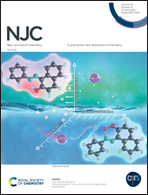Achieving long-lasting and high-capacity LiFe0.5Mn0.5PO4 cathodes with a synergistic F/In dual doping strategy†
Abstract
LiFe1−xMnxPO4 with elevated energy density is becoming the next-generation olivine-type cathode. However, its long cycling stability and delivered capacities are far from perfect, chiefly induced by its intrinsically poor ionic/electrical conductivities, sluggish electrode kinetics and notable Jahn–Teller effects upon charge/discharge cycles. Aimed at overcoming these barriers, we herein propose an efficient synergistic fluorine (F)/indium (In) dual doping strategy. As confirmed from the XRD Rietveld refinement results, the doped electronegative F can interact with Mn, thereby shortening Mn–O bond lengths, strengthening the covalent bonding nature and inhibiting the Jahn–Teller distortion/Mn dissolution, whereas the In doping helps to increase the electronic conductivity of particle cathodes, and opens up the crystal lattice spacing for expediting Li+ diffusion. As a proof-of-concept demonstration, the developed F/In-doped LiFe0.5Mn0.5PO4 cathodes exhibit less adverse phase variations, showing a maximum output capacity of 158.5 mA h g−1 at 0.1C, a capacity retention ratio over 86.7% after 500 cycles, and a markedly improved Mn discharge plateau capacity and capacity retention rate (at 2C). This work may not only shed new light on understanding the anion/cation co-doping effects for LiFe1−xMnxPO4, but also offer an applicable concept to design other high-energy-density electrode species.



 Please wait while we load your content...
Please wait while we load your content...